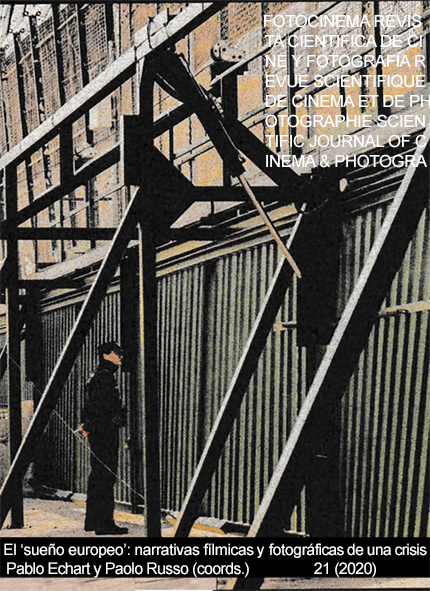The Sky Turns (2004): Mercedes Álvarez’s counter-monument to the idea of progress
DOI:
https://doi.org/10.24310/Fotocinema.2020.vi21.10008Keywords:
The Sky Turns, documentary, counter-monument, memory, progress, Mercedes ÁlvarezAbstract
The year 2020 marks the 16th anniversary of the premiere of The Sky Turns, Mercedes Álvarez's debut feature. Originally from Aldealseñor, Álvarez turns the spotlight on this tiny village in Soria (Castilla y León) as the real protagonist of her multi-awarded documentary. According to the synopsis of the film included in the commercial DVD, at that time only 14 men and women still lived there, none of them under age. Álvarez was, and still is, the last person born in Aldealseñor: The Sky Turns follows her return to her homeplace where she meets the locals at a time when the village is undergoing a process of modernisation devised, officially, with the aim of arresting its depopulation. Unofficially, though, The Sky Turns may be read as the counter-monument (to use the term coined by James E. Young) erected against an idea notion of progress.
Downloads
Metrics
References
Álvarez, M. (2009). ¿Por qué el documental? Arkadin, 2, pp. 74–77.
Arfuch, L. (2007). El espacio biográfico. Dilemas de la subjetividad contemporánea. Buenos Aires: Fondo de Cultura Económica.
Arfuch, L. (2018). La vida narrada: memoria, subjetividad y política. Chile: Editorial EDUVIM.
Barbeito, A. y Lo Vuolo, R. M. (1992). La modernización excluyente: transformación económica y estado de bienestar en Argentina. Argentina: Losada.
Barnouw, E. (1993). Documentary: A History of the Non-Fiction Film. Nueva York: Oxford University Press.
Bruzzi, S. (2006). New Documentary: A Critical Introduction. Londres: Routledge.
Cobo Durán, S. y Fernández Pichel, S. N. (2016). La ‘imagen resistencia’ en la obra documental de Mercedes Álvarez. En V., Guarinos (Ed.), Apuntes de cine: Homenaje a Rafael Utrera, pp. 27–37. Madrid: Delta.
Consejería de Cultura y Turismo de la Comunidad de Castilla y León (19-8-2013). Información relativa al expediente de declaración en la categoría de Monumento, del Bien de Interés Cultural denominado «Torre y Palacio Medieval» en Aldealseñor (Soria), delimitando su entorno de protección. BOCL, 158, pp. 56188–90. Recuperado de http://bocyl.jcyl.es/boletines/2013/08/19/pdf/BOCYL-D-19082013-65.pdf.
Cuevas, E. Cycles of Life: El cielo gira and Spanish Autobiographical Documentary. En A., Lebow (Ed.), The Cinema of Me: The Self and Subjectivity in First Person Documentary, pp. 79–97. Londres: Wallflower Press.
De La Torre Espinosa, M. (2015). Cines del yo: el documental autoficcional contemporáneo español. Bulletin of Hispanic Studies, 92, pp. 567–82. https://doi.org/10.3828/bhs.2015.33
Estrada, I. M. (2013). Otro viaje inquisidor hacia el pasado: El cielo gira (2005), de Mercedes Álvarez. En I.M., Estrada (Ed.), El documental cinematogra?fico y televisivo contempora?neo: memoria, sujeto y formacio?n de la identidad democra?tica espan?ola, pp. 115–34. Woodbridge: Tamesis.
Garci?a Landa, J. A. (1998). Accio?n, relato, discurso: estructura de la ficcio?n narrativa. Salamanca: Ediciones Universidad de Salamanca.
Krüger, Udo Michael (1988), Infos-Infotainment-Entertainment? Revista Media Perspektiven, 10, pp. 637–64.
Lebow, A. S. (2012). The Cinema of Me: The Self and Subjectivity in First Person Documentary. Londres: Wallflower Press.
López-Cordón, M. V. (1976). La revolución de 1868 y la I República. Madrid: Siglo XXI.
Lyotard, J.-F. (1994). La posmodernidad (explicada a los nin?os). Barcelona: Gedisa.
L-Quiñones, A. (2007). Más allá de la nostalgia: espacio, modernización y democracia en El cielo gira y En construcción. Revista de Estudios Hispánicos, 2, pp. 363–86.
Merino, I. (2007). Mercedes Álvarez. En J., Cerdán y C., Torreiro (Eds.), Al otro lado de la ficción. Trece documentalistas españoles contemporáneos, pp. 12–43. Madrid: Cátedra.
Ministerio de Cultura y Deporte. (2004). Catálogo de cine español. Recuperado de https://sede.mcu.gob.es/CatalogoICAA/Peliculas/Detalle?Pelicula=45002.
Nichols, B. (1997). La representación de la realidad. Cuestiones y conceptos sobre el documental. Barcelona: Paidós.
Nisbet, R. (1979). The Idea Of Progress. Literature of Liberty (vol. II), 1, pp. 33–35. http://oll-resources.s3.amazonaws.com/titles/1290/0353-05_1979v1_Bk_Sm.pdf
Pe?cheux, M. (1982). Language, Semantics and Ideology. Londres: Macmillan.
Piedras, P. (2014). El cine documental en primera persona. Buenos Aires: Paidós.
Plantinga, C. (1997). Rethoric and Representation in Nonfiction Film. Londres: Cambridge U.P.
Rancière, J. (2001). La fa?bula cinematogra?fica: reflexiones sobre la ficcio?n en el cine. Barcelona: Paidós.
Renov, M. (2004). The Subject of Documentary. Minnesota: University of Minnesota Press.
Riegl, A. (1987). El culto moderno a los monumentos. Caracteres y origen. Madrid: Editorial Visor Distribuciones.
Rifkin, J. (2004). The European Dream: How Europe’s Vision for the Future is Quietly Eclipsing the American Dream. Nueva York: Penguin.
Terdiman, R. (2018). Discourse/counter-discourse: The Theory and Practice of Symbolic Resistance in Nineteenth-Century France. Nueva York: Cornell U.P.
Toffler, A. (1996). Future Shock. Nueva York: Bantam Books.
Varda, A. (2014). Agne?s Varda: Interviews. Ed. Thomas Jefferson Kline. Jackson: University Press of Mississippi.
Weinrichter, A. (2004). Desvíos de lo real: el cine de no ficción. Madrid: T&B Editores.
Young, J. E. (2000). At Memory's Edge: After-images of the Holocaust in Contemporary Art and Architecture. New Haven: Yale U.P.
Downloads
Published
How to Cite
Issue
Section
License
All contents published in Fotocinema Revista científica de cine y fotografía are protected under the Creative Commons Attribution-NonCommercial-ShareAlike 4.0 International (CC BY-NC-SA 4.0) license. All about this license is available in the following link: <http://creativecommons.org/licenses/by-nc-sa/4.0>
Users can copy, use, redistribute, share and exhibit publicly as long as:
- The original source and authorship of the material are cited (Journal, Publisher and URL of the work).
- It is not used for comercial purposes.
- The existence of the license and its especifications are mentioned.
There are two sets of authors’ rights: moral and property rights. Moral rights are perpetual prerogatives, unrenounceable, not-transferable, unalienable, imprescriptible and inembargable. According to authors’ rights legislation, Fotocinema. Revista científica de cine y fotografía recognizes and respects authors moral rights, as well as the ownership of property rights, which will be transferred to University of Malaga in open access. The property rights are referred to the benefits that are gained by the use or the dissemination of works. Fotocinema. Revista científica de cine y fotografía is published in an open access form and it is exclusively licenced by any means for doing or authorising distribution, dissemination, reproduction, , adaptation, translation or arrangement of works.
Authors are responsable for obtaining the necessary permission to use copyrighted images.













13.png)




